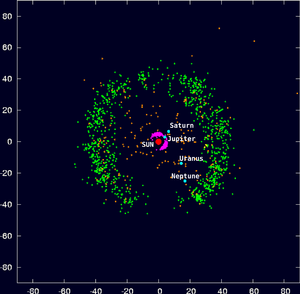
The rings of Uranus were discovered on March 10, 1977, by James L. Elliot, Edward W. Dunham, and Douglas J. Mink. Over 200 years ago, William Herschel also claimed to have observed these rings, although current astronomers are unsure that he could actually have noticed them, as they are very dark and faint. Two additional rings were discovered in 1986 in images taken by the Voyager 2 spacecraft, and two outer rings were found in 2003–2005 in Hubble Space Telescope[update] photos. By 2008 the Uranian ring system is known to consist of 13 rings. The rings are extremely dark. The rings are most likely composed of water ice. They are only a few kilometers wide. The rings are thought to be relatively young, no more than 600 million years old. The ring system probably originated from the collisional fragmentation of a number of moons that once existed around the planet. After colliding, the moons likely broke up into numerous particles, which survived as narrow and dense rings.







